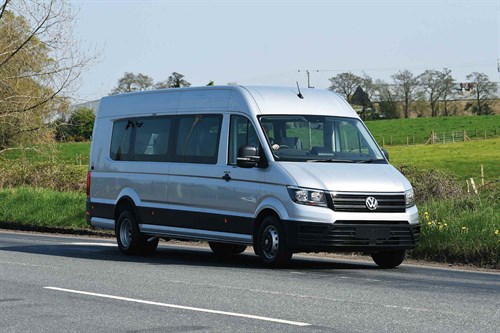- Renault gives UK debut to Master E-Tech at CV Show
- Isuzu D-Max long-term test – Latest Report
- Isuzu D-Max V-Cross Steel Edition revealed
- IVOTY Report: Stellantis explores the hydrogen proposition
- New Maxus EVs include eDeliver 5 van
- Used LCV values reach six-month high
- ADVERTISEMENT FEATURE: IVECO Daily Mission Awards 2024 Q2 Round-up: Grounds Maintenance & Forestry
- Stellantis Pro One electric vans review
- Mitie adds 5,000th EV to fleet
- Record number of CVs now on UK roads, SMMT reports
MINIBUSES: Electric-powered people movers
Date: Monday, October 14, 2019 | Author: Steve Banner

The 16-seat Volkswagen Crafter
(Continuted from previous page) Stanford Coachworks produces more mainstream minibuses too, and is a member of Ford’s Qualified Vehicle Modifier programme along with three other minibus converters: Alfred Bekker API, Lyndon Systems and Voyager MPV.
Ford builds Transit-based minibuses itself and is considerably better at building them than operating them. Earlier this year it shut down the Chariot minibus-based commuter shuttle service it had launched in London 12 months before. Using 14-seater Transits, some of which were wheelchair-accessible, it was set up to offer an alternative to passengers in areas of the capital not all that well served by buses or the tube.
London was the first Chariot operation to appear outside the US. Acquired by Ford in 2016 for a reputed £50m from its founders, who started it in San Francisco in 2014, it was active in a number of major cities in the US, including New York and Los Angeles. All the American operations were shut at the same time as the one in London.
Ford has given no clear explanation as to why it closed Chariot, but tough competition from Uber and similar organisations was probably a key factor.
Ford’s withdrawal is not deterring VW, however. MOIA, the VW group’s mobility services provider, hopes to run an on-demand minibus service in Ealing, London, in conjunction with bus operator RATP Dev using up to 10 L4H3 MAN TGEs. Travellers will be able to book a seat using an app or over the phone. The TGEs will not follow a fixed route, with users instead able to board one at flexible stops within a certain area.
Transport for London recently began a four-week consultation on the plan. “The scheme will help us to understand if a more flexible, on-demand offering will tempt people out of their cars,” says TfL director of transport innovation Michael Hurwitz.
A similar scheme is on trial in Sutton and none of the parties involved appear deterred by what happened to Chariot. “Having trials in two different locations in outer London, with a variety of different travel patterns, will give us a good understanding of whether it is possible to complement the existing bus network in areas that have been traditionally difficult to serve with conventional public transport,” says Hurwitz.
Minibus licensing
You can drive a minibus with up to 16 passenger seats on an ordinary car driver’s licence if you passed your car test on or after 1 January 1997, provided the vehicle is not being operated for hire or reward; you are 21 or older; you are doing so on a voluntary basis; you have held your driving licence for at least two years; if the maximum weight of the minibus is not more than 4.25t including the weight of any wheelchair ramp or lift that may be fitted; and you are not towing a trailer.
If you passed your car test prior to that date then you will probably have a D1 entitlement on your licence. That is the comprehensive minibus licence that among other things allows you to tow a trailer up to a maximum 750kg gross weight.
If you do not have a D1 entitlement, but want one, then you will have to take a separate test.
If the minibus is being operated with the aim of making a profit, however, then you will have to apply for a PCV – a passenger carrying vehicle licence – regardless of whether you have a D1 entitlement or not.
If the organisation running the minibus is doing so on a non-profit-making basis – if it is a church, for example – then it will require a permit issued under Section 19 of the Transport Act 1985, as amended. If it is using a minibus to run a not-for-profit community bus service then it will require a permit issued under Section 22 of the same act.
If payment is taken for carrying passengers with a view to making a profit then the business concerned will need to hold a PSV – public service vehicle – operator’s licence.
Bear in mind that the word ‘payment’ is interpreted quite widely. A private school that charges fees for pupils to attend will probably have to hold an operator’s licence, for example, because pupils are entitled to travel on its minibus as a consequence of fees being paid.
View The WhatVan Digital Edition


